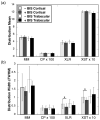Reduced cortical bone compositional heterogeneity with bisphosphonate treatment in postmenopausal women with intertrochanteric and subtrochanteric fractures
- PMID: 22072397
- PMCID: PMC4404705
- DOI: 10.1002/jbmr.560
Reduced cortical bone compositional heterogeneity with bisphosphonate treatment in postmenopausal women with intertrochanteric and subtrochanteric fractures
Abstract
Reduction of bone turnover with bisphosphonate treatment alters bone mineral and matrix properties. Our objective was to investigate the effect of bisphosphonate treatment on bone tissue properties near fragility fracture sites in the proximal femur in postmenopausal women with osteoporosis. The mineral and collagen properties of corticocancellous biopsies from the proximal femur were compared in bisphosphonate-naive (-BIS, n = 20) and bisphosphonate-treated (+BIS, n = 20, duration 7 ± 5 years) patients with intertrochanteric (IT) and subtrochanteric (ST) fractures using Fourier transform infrared imaging (FTIRI). The mean values of the FTIRI parameter distributions were similar across groups, but the widths of the parameter distributions tended to be reduced in the +BIS group relative to the -BIS group. Specifically, the widths of the cortical collagen maturity and crystallinity were reduced in the +BIS group relative to those of the -BIS group by 28% (+BIS 0.45 ± 0.18 versus -BIS 0.63 ± 0.28, p = 0.03) and 17% (+BIS 0.087 ± 0.012 versus -BIS 0.104 ± 0.036, p = 0.05), respectively. When the tissue properties were examined as a function of fracture morphology within the +BIS group, the FTIR parameters were generally similar regardless of fracture morphology. However, the cortical mineral:matrix ratio was 8% greater in tissue from patients with atypical ST fractures (n = 6) than that of patients with typical (IT or spiral ST) fractures (n = 14) (Atypical 5.6 ± 0.3 versus Typical 5.2 ± 0.5, p = 0.03). Thus, although the mean values of the FTIR properties were similar in both groups, the tissue in bisphosphonate-treated patients had a more uniform composition than that of bisphosphonate-naive patients. The observed reductions in mineral and matrix heterogeneity may diminish tissue-level toughening mechanisms.
© 2012 American Society for Bone and Mineral Research
Conflict of interest statement
Disclosures: JML consults for Amgen, BioMimetic Therapeutics, Inc., Bone Therapeutics, SA, CollPlant, Ltd., Graftys SA, and Zimmer; is a member of the Scientific Advisory Board of D'Fine, Inc. and Zimmer; and serves on the Speakers Bureau for Eli Lilly, Novartis, and Warner Chilcott. All other authors state that they have no conflicts of interest.
Figures



References
-
- Black DM, Delmas PD, Eastell R, Reid IR, Boonen S, Cauley JA, Cosman F, Lakatos P, Leung PC, Man Z, Mautalen C, Mesenbrink P, Hu H, Caminis J, Tong K, Rosario-Jansen T, Krasnow J, Hue TF, Sellmeyer D, Eriksen EF, Cummings SR. Once-yearly zoledronic acid for treatment of postmenopausal osteoporosis. N Engl J Med. 2007;356(18):1809–22. - PubMed
-
- Black DM, Thompson DE, Bauer DC, Ensrud K, Musliner T, Hochberg MC, Nevitt MC, Suryawanshi S, Cummings SR. Fracture risk reduction with alendronate in women with osteoporosis: the Fracture Intervention Trial. FIT Research Group. J Clin Endocrinol Metab. 2000;85(11):4118–24. - PubMed
-
- Harris ST, Watts NB, Genant HK, McKeever CD, Hangartner T, Keller M, Chesnut CH, 3rd, Brown J, Eriksen EF, Hoseyni MS, Axelrod DW, Miller PD. Effects of risedronate treatment on vertebral and nonvertebral fractures in women with postmenopausal osteoporosis: a randomized controlled trial. Vertebral Efficacy With Risedronate Therapy (VERT) Study Group. JAMA. 1999;282(14):1344–52. - PubMed
-
- Delmas PD, Recker RR, Chesnut CH, 3rd, Skag A, Stakkestad JA, Emkey R, Gilbride J, Schimmer RC, Christiansen C. Daily and intermittent oral ibandronate normalize bone turnover and provide significant reduction in vertebral fracture risk: results from the BONE study. Osteoporos Int. 2004;15(10):792–8. - PubMed
-
- Boonen S. Bisphosphonate efficacy and clinical trials for postmenopausal osteoporosis: Similarities and differences. Bone. 2007;40:S26–S31.
Publication types
MeSH terms
Substances
Grants and funding
LinkOut - more resources
Full Text Sources
Medical
Miscellaneous

